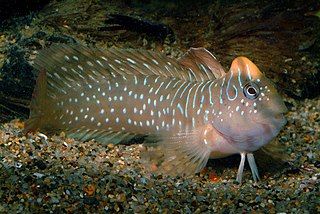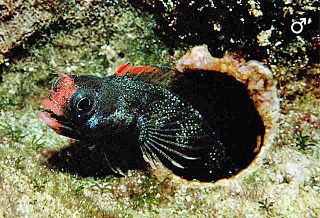
Combtooth blennies are blenniiformids; percomorph marine fish of the family Blenniidae, part of the order Blenniiformes. They are the largest family of blennies with around 400 known species. Combtooth blennies are found in tropical and subtropical waters in the Atlantic, Pacific and Indian Oceans; some species are also found in brackish and even freshwater environments.

Malacoctenus is a genus of labrisomid blennies native to the eastern Pacific Ocean and the Atlantic Ocean.
Protemblemaria punctata, the Warthead blenny, is a species of chaenopsid blenny endemic to the Atlantic coast of northeast Venezuela where it is found on shallow, sandy bottoms down to a depth of 20 metres (66 ft). This fish can reach a maximum size of 6 centimetres (2.4 in) TL.

Salaria is a genus of fish in the family Blenniidae. It contains both freshwater and marine species which are found around the Mediterranean Sea and the eastern Atlantic Ocean. One species, the peacock blenny, has colonised the northern Red Sea through the Suez Canal, a process knowns as anti-Lesspesian migration.

Blennius is a Genus of combtooth blenny in the family Blenniidae. Its members include Blennius ocellaris, the Butterfly Blenny.

Salarias is a genus of combtooth blennies found in the Indian and Pacific oceans.

Ecsenius is a large genus of fish in the family Blenniidae.

Acanthemblemaria is a genus of chaenopsid blennies native to the Atlantic and Pacific Oceans.

Blenniella is a genus of combtooth blennies found in the Pacific and Indian Oceans.

Cirripectes is a large genus of combtooth blennies found throughout the Pacific and Indian oceans.

Hypleurochilus is a genus of combtooth blennies found throughout the Atlantic Ocean.

Hypsoblennius is a genus of combtooth blennies found in the Pacific and Atlantic Oceans.

Meiacanthus is a genus of combtooth blennies found in the western Pacific and Indian oceans. Many species in this genus make their way into the aquarium trade and several are venomous. The genus name Meiacanthus is derived from the Greek meion meaning "less" and akantha meaning "thorn" and refers to most species having relatively few dorsal fin spines.

Parablennius is a diverse genus of combtooth blennies found in the Atlantic, western Pacific, and Indian oceans.

Emblemariopsis is a genus of flagblennies found throughout the Atlantic ocean.
Stathmonotus is a genus of chaenopsid blennies found in the Pacific and Atlantic oceans.
Paraclinus is a genus of labrisomid blennies native to eastern Pacific Ocean and the western Atlantic Ocean.

Starksia is a genus of labrisomid blennies native to the western Atlantic Ocean and the eastern Pacific Ocean. Their typical length is 2 cm (0.79 in) SL. The generic name honours the American ichthyologist Edwin Chapin Starks (1867-1932) of Stanford University for his work on Pacific coastal fishes.














